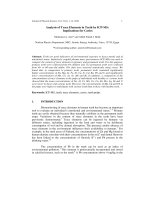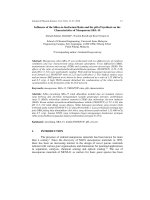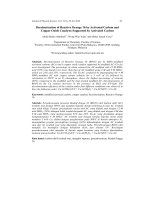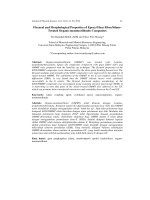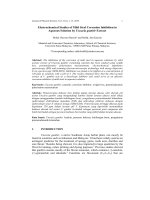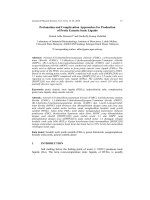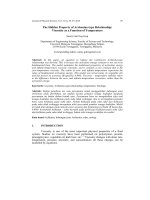Báo cáo vật lý: "Textural Characteristics of Activated Carbons Prepared from Oil Palm Shells Activated with ZnCl2 and Pyrolysis Under Nitrogen and Carbon Dioxide" doc
Bạn đang xem bản rút gọn của tài liệu. Xem và tải ngay bản đầy đủ của tài liệu tại đây (303.02 KB, 12 trang )
Journal of Physical Science, Vol. 19(2), 93–104, 2008 93
Textural Characteristics of Activated Carbons Prepared
from Oil Palm Shells Activated with ZnCl
2
and Pyrolysis Under Nitrogen and Carbon Dioxide
Allwar
*
, Ahmad Bin Md Noor and Mohd Asri Bin Mohd Nawi
School of Chemical Sciences, Universiti Sains Malaysia,
11800 USM, Pulau Pinang, Malaysia
Corresponding author:
Abstract: The textural characteristics of activated carbon prepared from oil palm shells
activated with zinc chloride (ZnCl
2
) and pyrolysis under nitrogen and carbon dioxide
were studied in this paper. The pyrolysis was carried out at different activation
temperatures in the range of 400
o
C–800
o
C. The BET surface areas obtained were in the
range of 1429.71–1134.74 m
2
g
–1
. The difference of values between micropore surface
area and external surface area showed that the activated carbons were predominantly
microporous adsorbents. The Dubinin-Astakhov (D-A) approach was used to study the
pore size diameter of activated carbon. The pore size diameters of activated carbons
obtained were in the range of 1.76–1.84 nm and the exponent (n) parameter in the range
of 1.2 to 1.6 indicated predominantly micropores. The Dubinin-Radushkevich
(D-R) method was used to evaluate the micropore volume of activated carbon. The
micropore volumes found were in the range of 0.74–0.619 cm
3
g
–1
. The structural
morphology and composition of activated carbons were evaluated by SEM-EDX. It was
clearly seen that the activated carbons were full of cavities, and some of Zn metals were
still trapped at the surface of activated carbons. In general, the heterogeneous and
predominantly microporous activated carbon was produced.
Keywords: activated carbon, nitrogen, carbon dioxide, activation, impregnation, zinc
chloride
1. INTRODUCTION
The two largest producer countries of palm oil in the world are Malaysia
and Indonesia. In Malaysia, oil palm shells containing high carbonaceous
materials are generated in large quantity as a major by-product of the oil palm
milling industry. Oil palm shells are usually burned as a low-value energy
resource or discarded in the field, both of which are unfavorable to the
environment. Due to high carbonaceous materials, oil palm shells are used as the
precursor in the production preparation of activated carbon.
1
Activated carbons are widely used as adsorbents. They represent
extremely versatile adsorbents of industrial significance and are widely used in
many applications which concern principally with the removal of undesirable
Textural Characteristics of Activated Carbons 94
species from liquids or gases. They are also used as catalysts or catalyst supports
or gas storages.
For these applications, activated carbons are required to possess a high
specific surface area and controllable pore size distribution. These properties are
very important in the field of activated carbon design. They can be produced by
either physical or chemical activation process. Chemical activation is the most
commonly used process for preparing activated carbon due to its lower activation
temperature and excellent properties for the product compared to physical
activation process. Normally, phosphoric acid and ZnCl
2
are widely used as
chemical agents in the chemical activation process.
2–5
Analysis of physical properties of the activated carbon involves the
determination of the total surface area, the extent of microporosity and the pore
size distribution. These are very important indicators for the suitability of
activated carbon as an adsorbent. The nitrogen adsorption-desorption isotherm at
low temperature (–196
o
C) is commonly used for the analysis of the physical
properties. Determination of total surface area is commonly based on the theory
of multilayer adsorption developed by Brunauer, Emmett and Teller with the
relative pressure (p/p
o
) in range of 0.05–0.30.
6–8
The extent of microporosity is
commonly evaluated by applying t-method involving micropore surface area and
external surface area within the relative pressure in the range of 0.2–0.5.
9
The
micropore volume is evaluated using the D-R method. The pore size distribution
with respect to mesopore is measured by the Barrett, Joyner and Helenda (BJH)
method.
10–12
The micropore size distribution is measured by the D-A method by
applying low relative pressure region of adsorption isotherm.
The aim of this work was to prepare and study the effect of different
pyrolysis temperatures on the development of the porosity of activated carbon
derived from oil palm shells activated with ZnCl
2
. The activated carbon was
prepared from solid waste of oil palm shell by two-stage methods in order to
obtain the maximal adsorptive capacities.
2. EXPERIMENTAL
2.1 Reactor
The stainless steel reactor for the pyrolysis of oil palm shells with 12 cm
in diameter, 25 cm in height and 5 mm in thickness. The size of reactor was
suitable to be placed inside the Nabertherm graphite furnace. The gas inlet and
outlet were designed at the bottom and top of the reactor, respectively, using
Journal of Physical Science, Vol. 19(2), 93–104, 2008 95
stainless steel pipes. Figure 1 shows the schematic diagram of the set-up for the
pyrolysis of oil palm shell.
2.2 Material
The raw material for the preparation of activated carbon was the oil palm
shells collected from an oil palm mill at Nibong Tebal, Malaysia. The oil palm
shells as received were washed with water to reduce oily impurities and dried in
the oven at 110
o
C. The dried oil palm shells were ground in a blender and sieved
to a particle size of 0.5–1.5 mm.
2.3 Chemical Activation with ZnCl
2
About 250 g of oil palm shells with particle size of 0.5–1.5 mm was
added into 500 ml of 65% ZnCl
2
solution. The mixture was refluxed in water
bath at 85
o
C for 24 h. Thereafter, the mixture was filtered and the residue was
washed with hot distilled water and dried in oven at 110
o
C for 24 h. The
impregnated sample was pyrolyzed in two stages. First, the reactor was loaded
with impregnated sample and then placed into the graphite furnace. Purified
nitrogen was allowed to flow into the reactor at a constant flow rate of
200 cm
3
min
–1
. At the same time, the furnace was gradually heated at the
constant heating rate 5
o
C min
–1
from the ambient temperature to the pyrolysis
temperature. The temperatures were set at 400
o
C, 500
o
C, 600
o
C, 700
o
C and
800
o
C with the contact time of 3 h at each of the activation temperatures. After
cooling to the ambient temperature, the sample was washed with hot distilled
water for several times until pH 6–7 and then dried in the oven at 110
o
C.
In the second stages of pyrolysis, purified carbon dioxide gas was used
instead of nitrogen with the contact time of 90 min at each of the activation
temperatures. The activated carbon produced was washed with distilled water
and then dried in the oven at 110
o
C for 24 h.
Figure 1: Schematic diagram for pyrolysis. (A) Electrical graphite furnace; (B) rector;
(C) gas tank; (D) flow meter; (E) inlet gas trap silicate; (F) outlet gas trap
water; (G) temperature controller.
Textural Characteristics of Activated Carbons 96
2.4 Characterization of the Activated Carbons
2.4.1 Nitrogen adsorption studies
The determination of the adsorption-desorption nitrogen isotherms was
carried out at the temperature of –196
o
C and the relative pressure in the range of
0.005–0.99 using a surface area analyzer (Quanthachrome Nova 2200e). Data
was analyzed for the BET surface area, micropore surface area, external surface
area, micropore and total pore volume, and pore size distribution. The specific
surface areas were analyzed according to the BET method at the relative pressure
in the range of 0.05–0.30.
15–17
Micropore surface area and external surface area
were obtained from the t-plot method whereas total pore volume was directly
calculated from the volume of nitrogen held at the highest relative pressure
(p/p
o
= 0.99). The micropore volume was estimated from the D-R plots at the
relative pressure of < 0.1. Pore size diameters were determined by the D-A
method at the relative pressure in the range of 0.1–0.005. All calculations were
performed using the program of Quanthachrome Nova 2200e surface area
analyzer.
2.4.2 Structural morphology
Scanning Electron Microscopy (SEM) and Energy Dispersive X-ray
analysis (EDX) were used to observe the structural morphology and composition
of activated carbon.
3. RESULTS AND DISCUSSION
3.1 BET Surface Area of Activated Carbon
Some studies concerning the preparation of activated carbon from oil
palm shells with chemical activation had been reported.
18–20
The textural
characteristics of the activated carbon prepared from oil palm shells pyrolyzed at
different activation temperatures under nitrogen and carbon dioxide are reported
in Table 1. The textural characteristics of activated carbon involving BET surface
area, micropore surface area, external surface area, micropore volume, total pore
volume, average pore size diameter and pore size diameter are very important
because they are closely related to the adsorptive capacities.
21
The pyrolysis at
the activation temperature of 500
o
C was found to provide the highest BET
surface area, 1429.71 m
2
g
–1
. In general, activated carbon activated with ZnCl
2
produced high surface area in the range of 1148.18–1429.71 m
2
g
–1
.
Table1: Textural characteristics of activated carbon at different activation temperatures.
Journal of Physical Science, Vol. 19(2), 93–104, 2008 97
Temp.
(
o
C)
BET
surface
area
(m
2
g
–1
)
Micropore
surface
area
(m
2
g
–1
)
External
surface
area
(m
2
g
–1
)
D-R
micropore
volume
(cm
3
g
–1
)
Total pore
volume
(p/p
o
= 0.99)
(cm
3
g
–1
)
Average
pore size
diameter
(nm)
D-A pore size
diameter (nm)
400 1148.18 973.1 175.1 0.54 0.62 2.16 1.76 (n = 1.6)
500 1429.71 1024.3 404.4 0.74 0.77 2.16 1.84 (n = 1.2)
600 1297.09 842.2 454.9 0.53 0.71 2.18 1.84 (n = 1.2)
700 1317.22 975.1 342.1 0.58 0.71 2.14 1.80 (n = 1.4)
800 1134.74 694.2 440.6 0.46 0.63 2.22 1.82 (n = 1.3)
Table 1 shows that the BET surface area of activated carbon increased
from 1148.18 to 1428.71 m
2
g
–1
with increasing of the activation temperatures
from 400
o
C to 500
o
C; thereafter, decreased at higher activation temperatures. At
the activation temperature of 400
o
C, the developing rudimentary pores of
activated carbon were formed by removing the low-molecular-weight volatile
compounds from the matrix structure. Increasing the activation temperature to
500
o
C enhanced the removal of molecular weight volatile compounds and further
created new pores, resulting in the acceleration of porosity development of the
activated carbon. The presence of ZnCl
2
as an impregnation agent would increase
the heat energy on the pyrolysis process, and thus initiate to develop the porosity
of activated carbon.
22
However, when the activation temperature was increased
to 600
o
C, excessive heat energy was given to the carbon resulting in the
knocking and breaking of some of porous wall, thus blocking the porosity
formation. Hence, the pyrolysis at this activation temperature would yield
decreasing BET surface area, micropore surface area, external surface area,
micropore volume, total pore volume but increasing average pore size
distribution.
3.2 Other Textural Characteristics of Activated Carbon
Figure 2 shows the nitrogen adsorption-desorption isotherms at –196
o
C
on the activated carbon prepared at different activation temperatures in the range
of 400
o
C–800
o
C. All of the plots exhibit typical Type I isotherm with a well-
developed sharp ''knee'' at the low relative pressure that tend to become almost a
plateau at higher relative pressure. The type I isotherm indicated the presence of
microporous adsorbents with relatively small external surface at low relative
pressure of < 0.1.
23
A
B
C
Figure 2: Nitrogen adsorption-desorption isotherms at –196
o
C on the activated carbon
prepared from oil palm shells activated with ZnCl
2
and at various pyrolysis
temperatures. (A) 400
o
C; (B) 500
o
C; (C) 600
o
C (D) 700
o
C; (E) 800
o
C.
(continued next page)
Journal of Physical Science, Vol. 19(2), 93–104, 2008 99
D
E
Figure 2: (continued)
Figure 3 shows the various curves of pore size distributions of activated
carbon prepared at different pyrolysis temperatures. All of the pore size
distribution curves of activated carbon have their maxima at the pore diameter
less than 2 nm indicating the presence of micropores. The micropore diameters
were determined to be in the range of 1.76–1.84 nm. Micropore volumes were
evaluated using the D-R equation at the relative pressure in the range of
0.1– 0.005 and the results are shown in Table 1. The micropore volume increased
with increasing activation temperature from 400
o
C to 500
o
C, but thereafter,
decreased with further activation temperature increase. At the activation of
500
o
C, the maximum micropore volume was 0.74 cm
3
g
–1
. At the lower pyrolysis
Textural Characteristics of Activated Carbons 100
2.2E+000
2.1E+000
2.0E+000
1.8E+000
1.7E+000
1.6E+000
1.5E+000
1.3E+000
1.2E+000
1.1E+000
9.8E+000
8.6E+000
7.3E+000
6.1E+000
4.9E+000
3.7E+000
2.4E+001
1.2E+001
0.0E+000
dv (log d)
0.300 0.600 1.000 2.000 3.000 4.000 10.000 20.000 30.000 50.000 100.000 200.000
Figure 3: Pore size distributions of activated carbon prepared by chemical activation
with 65% ZnCl
2
at different pyrolysis temperatures.
temperature of 400
o
C, the heat energy of pyrolysis was not enough to develope
porosity and produced low micropore volume of activated carbon. However, the
decrease of micropore volume at higher pyrolysis temperatures in the range of
600
o
C–800
o
C was caused by a contraction or breaking of some of the porous
wall of activated carbon, thus blocking the pores.
It was noticed that D-A method was usually used to evaluate the
micropores of activated carbon. The D-A equation required the characteristic
energy (Eo) and n parameter distributions. In this approach, n reflects the width
of the energy distribution, which is related to the pore size distribution. Values of
n between 1 and 4 have been obtained for large carbon adsorbents. Values of
n > 2 provide homogeneous micropores with narrow micropore of small size
range, while values of < 2 are found for heterogeneous carbon with a wide range
of pore size such as conversion of micropore to mesopores and macropores. As
showed in Table 1, the values of n for activated carbon prepared by chemical
activation with ZnCl
2
ranged from 1.6 to 1.2 which indicated to heterogeneous
activated carbon with wide size range of micropores.
3.3 Surface Morphology of Activated Carbon
Scanning electron macrographs for the external morphology of the
activated carbon at the pyrolysis temperature of 500
o
C are displayed in Figure 4.
It can be seen that the external surface of activated carbon is full of cavities.
Journal of Physical Science, Vol. 19(2), 93–104, 2008 101
A
B
Figure 4: Structural morphology of activated carbon prepared by chemical activation
with ZnCl
2
at 500
o
C. (A) Magnitude of 4980x; (B) magnitude of 15000x.
The composition of resulted activated carbon was determined by the
EDX analysis. Some Zn metals found to be trapped at the surface of the activated
carbon are shown in Figure 5.
3. CONCLUSION
Oil palm shell, a waste from oil palm milling industry, is a good material
to prepare activated carbon which possesses high adsorptive capacities.
Development of the porosity of activated carbon was affected by the activation
temperature and the presence of ZnCl
2
for impregnation. The maximum surface
Textural Characteristics of Activated Carbons 102
Figure 5: Composition of activated carbon prepared by chemical activation with 65%
solution of ZnCl
2
at the pyrolysis temperature of 500
o
C.
area of 1429.71 m
2
g
–1
was obtained at the activation temperature of 500
o
C.
The value of micropore surface area was much higher than the value of external
micropore area, indicating that the activated carbon consisted of predominantly
micropores. Nitrogen adsorption-desorption isotherm showed Type I indicating
the presence of micropore activated carbon. The micropore volume and pore
diameter were evaluated by the D-R and D-A methods, respectively, yielding the
maximum micropore volume (0.74 cm
3
g
–1
) and small pore diameter (< 2 nm).
Textural morphology of activated carbon determined by the SEM-EDX clearly
showed that the activated carbon was full of cavities. Some Zn metals were
found at the surface of the activated carbon.
ACKNOWLEDGMENT
The authors thank the Universiti Sains Malaysia, Pulau Pinang, Malaysia
and the University Islam Indonesia, Yogyakarta, Indonesia. This work was
supported by Project Penyelidikan Universiti Sains Malaysia account number
1001/PKIMIA/811007.
Journal of Physical Science, Vol. 19(2), 93–104, 2008 103
4. REFERENCES
1. Tan, J.S. & Ani, F.N. (2004). Carbon molecular sieve produced from oil
palm shell for air separation. Sep. Purif. Technol., 35, 47–54.
2. Ahmadpour, A. & Do, D.D. (1996). The preparation of activated carbons
from coal by chemical and physical activation. Carbon, 34(4), 471–479.
3. Diao, P., Walawender, W.P. & Fan, L.P. (2002). Activated carbon
prepared from phosphoric acid activation of grain sorghum. Bioresource
Technol., 81, 45–52.
4. Guo, Y. & Rockstraw, D.A. (2007). Physicochemical properties of
carbons prepared from pecan shell by phosphoric acid activation.
Bioresource Technol., 98, 1513–1521.
5. Ganan-Gomez, J., Marcias-Garcia, A., Diaz-Diaz, M.A., Gonzales-
Garcia, C. & Sabio-Rey, E. (2006). Preparation and characterization of
activated carbons from impregnation pitch by ZnCl
2.
Appl. Surf. Sci.,
252, 5976–5979.
6. Brunauer, S. & Emmett, P.H. (1937). J. Am. Chem. Soc., 59, 2682.
7. Brunauer, S., Emmett, P.H. & Teller, E. (1938). J. Am. Chem. Soc.,
60, 309.
8. Gregg, S.J. & Sing, K.S.W. (1982). Adsorption, surface area and
porosity. London: Academic Press, 303.
9. Girgis, B.S., Attia, A.A. & Fathy, N.A. (2007). Modification in
adsorption characteristics of activated carbon produced by H
3
PO
4
under
flowing gases. Colloid Surface A, 299, 79–87.
10. Barret, E.P., Joyner, P.B. & Haklenda, P. (1951). The determination of
pore volume and size distribution in porous substances I. Computation
from nitrogen isotherm. J. Am. Chem. Soc.,73, 373–80.
11. Rouquerol, F., Rouquerol, J. & Sing, K.S.W. (1999). Adsorption by
powders and porous solids principles. methodology and applications.
San Diego, CA: Academic Press.
12. Leofanti, G., Padovan, M., Tozzola, G. & Venturelli, B. (1998). Surface
area and pore texture of catal. Catal. Today, 41, 207–219.
13. Gil, A., Korili, S.A. & Cherkashinin, G.Y. (2002). Extension of the
Dubinin-Astakhov equation for evaluating the micropore size
distribution of a modified carbon molecular sieve. J. Colloid Interf. Sci.,
262, 603–607.
14. Hu, H.U. & Ruckenstein, E. (2006). Application of Dubinin-Astakhov
equation to CO
2
adsorption on single-walled carbon nanotubes. Chem.
Phys. Lett., 425, 306–310.
Textural Characteristics of Activated Carbons 104
15. Terzyk, A.P., Gauden, P.A., Zawadzki, J., Rychlicki, G., Wisniewski, M.
& Kowalczk, P. (2001). Toward the characterization of microporosity of
carbonaceous films. J. Colloid Interf. Sci., 243, 183–192.
16. Kenneth, S. (2001). The use of nitrogen adsorption for the
characterization of porous materials. Colloid Surface A, 187–188, 3–9.
17. Sing, K.S.W. (1998). Adsorption methods for the characterization of
porous materials. Adv. Colloid Interfac., 76–77, 3–11.
18. Lua, A.C., Lau, F.Y. & Guo, J. (2006). Influence of pyrolysis condition
on pore development of oil palm-shell activated carbons. J. Anal. Appl.
Pyrol., 76, 1–2, 92–102.
19. Guo, J. & Luo, A.C. (2002). Characterization of adsorbent prepared from
oil-palm shell by CO
2
activation for removal of gaseous pollutants.
Mater. Lett., 55, 334–339
20. Guo, J. & Lua, A.C. (2002). Microporous activated carbons prepared
from palm shell by thermal activation and their application to sulfur
dioxide adsorption. J. Colloid Interf. Sci., 251, 242–247.
21. Janskowska, H., Swiatkowski, A. & Choma, J. (1991). Activated carbon.
New York: Ellis Harwood.
22. Mun, S.P. & Seo, G. (2004). Preparation of activated carbon from Pinus
desiflora bark by ZnCl
2
activation. J. Ind. Eng. Chem., 10(5), 728–732.
23. Storck, S., Bretinger, H. & Maier, W.F. (1998). Characterization of
micro- and mesoporeous solids by physisorption methods and pore-size
analysis. Appl. Catal. A-Gen., 174, 137–146.
